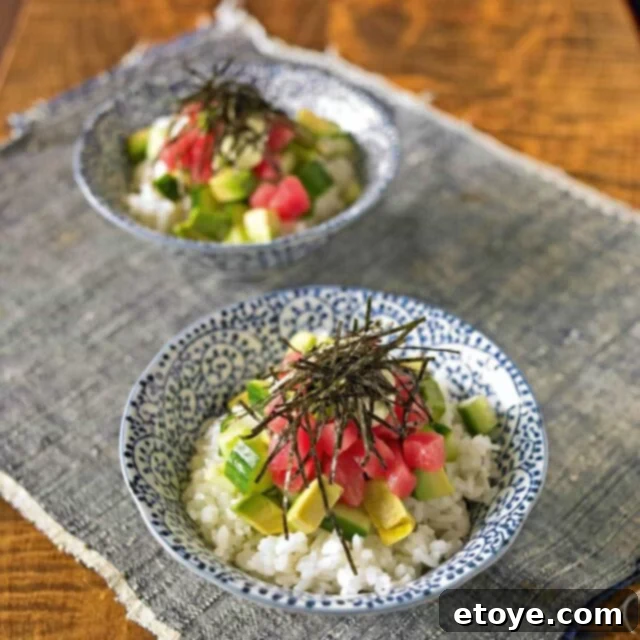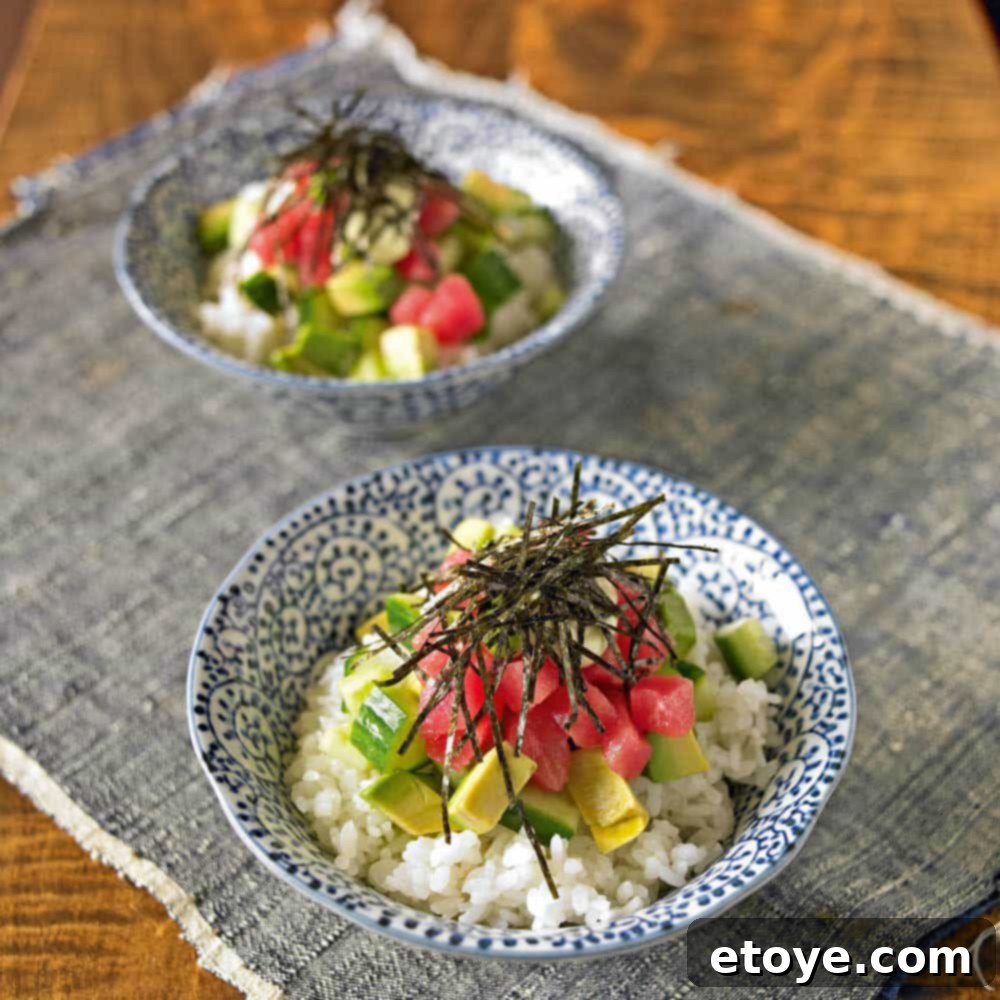
Easy & Delicious Sushi Rice Bowl (Chirashi Don) Recipe
For all sushi aficionados, the vibrant and flavorful sushi rice bowl, also known as chirashi-don, offers a fantastic way to indulge in those beloved, clean Japanese flavors without the intricate process of rolling or hand-shaping sushi. This delightful dish brings the essence of traditional sushi directly to your bowl, making it an accessible and enjoyable culinary experience for home cooks.
If your local supermarket conveniently stocks high-quality sushi-grade fish, you’re already well on your way to preparing a stunning sushi rice bowl that rivals those served in upscale Japanese restaurants. Imagine serving this fresh and colorful creation to your guests – it’s sure to impress!
Our featured sushi rice bowl celebrates the fresh taste of **sushi-grade tuna**, perfectly complemented by the essential elements of Japanese cuisine: **perfectly seasoned Japanese short-grain rice, crisp, bite-sized chunks of cucumber, and creamy avocado.** The dish is elegantly finished with delicate slivers of roasted seaweed, adding a subtle oceanic depth and visual appeal.
To enhance the experience, a generous dollop of homemade spicy mayonnaise and a drizzle of a light wasabi-soy sauce dressing elevate the flavors. I personally prefer to dilute the soy sauce with a few drops of water; I find undiluted soy sauce can be too rich and salty when poured directly over the delicate rice and fish.

Mastering Japanese Flavors: The Debra Samuels Way
This fantastic sushi rice bowl recipe comes to us from a respected author at Tuttle Publishing, Debra Samuels. Debra is an authority on Japanese home cooking, having lived in Japan for over a decade since the 1970s, where she meticulously studied the nuances of the local cuisine. Her extensive experience and passion shine through in her simplified, yet authentic, recipes.
Beyond her cookbooks, Debra is a distinguished food journalist for The Boston Globe and has also authored My Korean Table Cookbook. Her culinary philosophy centers around making delicious, comforting dishes accessible to everyone. You won’t find overly complicated techniques or elusive ingredients in Debra’s works; instead, she champions honest, homestyle cooking using ingredients readily available at most well-stocked grocery stores. This makes her recipes perfect for anyone looking to explore Japanese cuisine without intimidation.
The particular book we are highlighting today is My Japanese Table. This cookbook is a treasure trove of authentic Japanese recipes, covering a wide array of dishes from everyday meals to celebratory feasts. Some of the tempting recipes you’ll discover within its pages include:
- Spicy Tuna Tartar
- A comprehensive step-by-step guide on how to roll traditional sushi
- Fried Cabbage and Pork Noodles (Yakisoba)
- Expert tips on how to host your very own Yakitori party
- Mouth-watering Succulent Salmon Teriyaki
- The art of preparing a beautiful and balanced Bento box
- And, of course, the star of our show: chirashi-don, the delightful sushi rice bowl!
Are you craving these incredible flavors yet? This versatile cookbook empowers you to bring the authentic taste of Japan right into your kitchen.
I specifically chose this sushi rice bowl recipe, featuring fresh tuna, crisp cucumber, creamy avocado, and a tantalizing spicy mayonnaise, because it offers an incredibly straightforward and satisfying way to enjoy “sushi” without needing to master the often-tricky art of sushi rolling. All the ingredients are easy to source at most standard grocery stores, eliminating the need for a specialized Asian market visit, making it perfect for a weeknight meal or a casual gathering.
What Makes a Sushi Rice Bowl So Special?
Sushi rice bowls, or chirashi-don, translate to “scattered sushi,” perfectly describing their delightful presentation of various toppings scattered over a bed of seasoned sushi rice. They offer all the beloved flavors and textures of traditional sushi in a deconstructed, easy-to-eat format. This makes them a fantastic option for beginners, busy individuals, or anyone who simply prefers a spoon and a bowl over chopsticks and delicate rolls.
The Appeal of Chirashi-don:
- Simplicity: No complex rolling techniques required. Just assemble your ingredients!
- Customization: Easily adapt to your preferences. Don’t like tuna? Use salmon! Vegetarian? Load up on veggies and tofu.
- Health Benefits: Packed with lean protein from fish, healthy fats from avocado, and fresh vegetables.
- Visual Appeal: A colorful and attractive dish that’s as pleasing to the eye as it is to the palate.
- Versatility: Perfect for a quick lunch, a light dinner, or an impressive dish for entertaining.
Debra Samuels’ Philosophy in Practice:
“This chirashi-don recipe artfully combines two of my most cherished fresh tuna dishes: the first being a tuna tartare gracefully presented atop rice and subtly veiled with grated Japanese yam (yamakake); and the second, a captivating appetizer of exquisitely layered fresh tuna and avocado cubes, all brought together with a vibrant Spicy Mayonnaise dressing. This latter delight was a discovery I made alongside Miho Nakajima, who was a teenage neighbor back then and is now an elegant banker in central Tokyo. For this particular recipe, you won’t necessarily season the tuna itself. As for the seaweed, instead of wrapping, you’ll simply cut it into fine shreds and artfully place it directly over the tuna. The result is an absolutely delightful mouthful of goodness that truly captures the essence of Japanese home cooking.”
How to Choose Sushi-Grade Tuna
(Tuna image from Monterey Bay Seafood Watch)
The success of any sushi bowl hinges on the quality and freshness of your fish. When selecting tuna for your sushi bowl, the label “sushi-grade” is paramount. This designation indicates that the fish has been handled and stored in a way that makes it safe for raw consumption. Always purchase your fish from a reputable fishmonger and don’t hesitate to ask these crucial questions:
- When was this fish defrosted? (It’s important to know that most tuna, even sushi-grade, arrives frozen to ensure safety and freshness. Understanding when it was defrosted helps assess its current freshness.)
- Ask to smell the fish: A truly fresh piece of sushi-grade tuna should have a clean, subtle ocean scent, not a strong “fishy” odor. If it smells off, do not buy it.
- Ask your fishmonger to gently press the flesh of the fish: Fresh tuna will spring back when lightly pressed. If the flesh remains indented, feels tacky, or sticky, it indicates older fish.
- Inquire about the fish’s origin and how it was caught: Prioritizing environmentally friendly options is crucial. Look for tuna that is troll- or pole-caught, especially varieties like Albacore from the U.S., which are often more sustainable. For a comprehensive guide on sustainable seafood choices, consult the Monterey Bay Aquarium Seafood Watch Guide, which grades various fish based on their sustainability metrics. You can find their specific recommendations for tuna on their tuna page.
Beyond tuna, don’t be afraid to explore other sushi-grade options like salmon, yellowtail (hamachi), or even scallops. Variety adds an extra layer of enjoyment to your homemade sushi bowls.
The Art of Sushi Rice: More Than Just Cooked Grains
The foundation of any great sushi bowl is, without a doubt, the rice. It needs to be short-grain, perfectly cooked, and seasoned to achieve that signature sticky, slightly sweet, and tangy profile. While Debra’s original recipe might detail the traditional method using kombu, this adapted version simplifies the process for the home cook using readily available seasoned rice vinegar. Make sure to purchase “seasoned rice vinegar” or “sushi rice vinegar,” as these varieties already contain sugar and salt, providing the perfect balance for your sushi rice.
Essential Tips for a Perfect Sushi Rice Bowl
- Seaweed Shreds (Kizami Nori): For convenience, you can buy regular sushi seaweed (nori) sheets and use kitchen shears to cut them into thin strips. This adds an authentic touch and a delightful umami flavor.
- Cucumber Choice: English or Japanese cucumbers are highly recommended due to their crisp texture and fewer seeds. If using a regular cucumber, it’s best to remove the watery seeds. Simply slice the cucumber in half lengthwise and use a small spoon to scrape out the seeds before dicing.
- Soy Sauce Dilution: While personal preference dictates, diluting soy sauce with a few drops of water can prevent it from overpowering the delicate flavors of the fish and rice.
- Avocado Freshness: Toss diced avocado with a little lemon juice to prevent browning and keep it looking vibrant.
- Sharp Knife: When dicing sushi-grade fish, a very sharp knife is essential for clean cuts and maintaining the fish’s integrity.
- Gentle Mixing: When seasoning the rice, use a spatula in a folding motion to avoid mashing the grains.
Sushi Rice Bowl Recipe
Recipe adapted from My Japanese Table by Debra Samuels. Reprinted with Permission, Tuttle Publishing. Recipe photo by Heath Robbins.
Debra’s cookbook includes instructions for the traditional way of cooking rice and sushi rice, using kombu (kelp). I’ve modified her recipe to include my version of a simplified sushi rice, using seasoned rice vinegar found at most grocery stores. Make sure you buy “Seasoned Rice Vinegar” or “Sushi Rice Vinegar” — which includes sugar in the ingredients.
Tips: For the seaweed, I just buy regular sushi seaweed and use kitchen shears to cut into shreds. English and Japanese cucumbers have less seeds than regular cucumber and are crunchier. If using regular cucumber, it’s best to get rid of the watery seeds. Slice cucumber in half, lengthwise and use a small spoon to scrape out the seeds. I prefer to dilute the soy sauce with just a few drops of water, but I’ll leave that up to you!
Prep Time: 30 mins
Cook Time: 30 mins
Servings: 4
Ingredients
MAIN INGREDIENTS
- 1 English cucumber
- 1 pound sushi-grade tuna
- 2 small avocados
- 2 tablespoons fresh lemon juice
- Roasted seaweed shreds (kizami nori)
- Soy sauce, preferably low sodium, for drizzling
- Wasabi, to taste
FOR THE SPICY MAYONNAISE
- 1 cup mayonnaise
- 1 teaspoon Sriracha sauce (or other spicy chili sauce)
- 1/2 teaspoon Asian sesame oil
- 2 teaspoons low-sodium soy sauce
FOR THE SUSHI RICE (makes 4 cups cooked)
- 2 cups short-grain white rice
- 3-4 tablespoons seasoned rice vinegar
Instructions
- Cook the rice: Put the rice into a medium saucepan. Run cold water into the saucepan, and with your hand, swish the rice around. Drain water into the sink. Repeat 3 more times, until water is more clear. Fill saucepan with 2 1/4 cups of water. Cover with lid. Cook rice over medium heat for 10 minutes. Lower heat to low and cook for an additional 10 minutes. Remove from heat, do not open lid. Let rice sit for 5 minutes or more to steam.
- Prepare the Spicy Mayonnaise: While the rice is cooking, prepare the Spicy Mayonnaise. In a small bowl, whisk together the mayonnaise, Sriracha, Asian sesame oil, and low-sodium soy sauce until well combined and smooth. Set aside.
- Prepare the toppings: Cut the cucumber, sushi-grade tuna, and avocados into uniform 1/2-inch dice. In a small bowl, gently toss the diced avocado with the fresh lemon juice to prevent browning. Cover the avocado with plastic wrap and set aside until ready to assemble the bowls.
- Season the rice: When the rice has cooked and rested, open the lid and transfer the hot rice to a large, wide bowl (preferably wooden, if available). Using a spatula, gently fold and lift the rice to allow steam to escape and to help it cool evenly. Be careful not to mash the rice or mix too vigorously, as this can break the delicate rice kernels. After most of the steam has been released and the rice has cooled slightly, gradually dribble in a little of the seasoned rice vinegar. Continue to fold and lift the rice to ensure the vinegar is evenly distributed. Repeat this process with the remaining rice vinegar until all the rice is lightly seasoned. Keep the rice covered with a damp cloth until ready to serve. Do not refrigerate, as this can make the rice hard.
- Assemble and serve: To serve, divide the perfectly seasoned sushi rice evenly among 4 individual bowls. Artfully arrange the diced cucumber and avocado over the rice, followed by the fresh sushi-grade tuna. Spoon a generous dollop of the prepared Spicy Mayonnaise on top of each bowl. Garnish with the shredded roasted seaweed (kizami nori). Serve immediately with additional soy sauce (diluted if desired) and wasabi on the side, allowing each person to customize their bowl to taste.
Let us know how it was!
Perfect Pairings for Your Sushi Rice Bowl
A sushi rice bowl is a complete meal on its own, but certain accompaniments can elevate the experience even further.
- Miso Soup: I highly recommend pairing your sushi rice bowl with a warm bowl of miso soup. Its savory, comforting broth is the perfect complement to the fresh flavors of the chirashi-don. Explore Four Ways to Make Miso Soup or jump straight to a classic Miso Soup with Mushrooms!
- Crispy Tofu: The Japanese often enjoy pairing chirashi, or any raw fish dish, with something light and crispy. This Crispy Tofu with Citrus Soy Sauce offers a wonderful textural contrast and a burst of complementary flavor.
- Hand Rolls (Temaki): If your sushi streak is truly on fire, why not try your hand at Hand Rolls (Temaki)? They’re another fun and interactive way to enjoy sushi without the full commitment of traditional rolls.
- Pickled Ginger and Wasabi: Always have these on hand to cleanse your palate and add a kick.
- Green Tea or Sake: A traditional Japanese green tea or a light sake can beautifully accompany the meal, enhancing the authentic dining experience.
Embrace the Simplicity of Chirashi-don
The beauty of the sushi rice bowl lies in its elegant simplicity and the harmonious blend of fresh, high-quality ingredients. It’s a celebration of Japanese flavors that is both easy to prepare and incredibly rewarding to eat. Whether you’re new to Japanese cooking or a seasoned enthusiast, this chirashi-don recipe provides a perfect entry point into the world of homemade sushi without the fuss. So gather your ingredients, follow these straightforward steps, and create a truly memorable meal that will transport your taste buds straight to Japan!
Enjoy your journey into the delightful world of sushi rice bowls!
